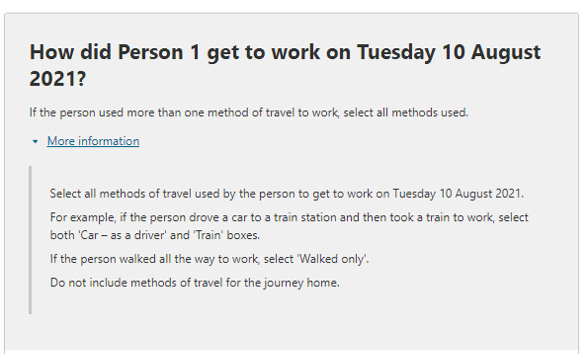Image

Description
Example
Image

Description
More information
Image

Persons aged 15 years or over who have labour force status of ‘employed’
| Code | Category |
|---|---|
| 1 | Public transport |
| 2 | Vehicle |
| 3 | Active transport |
| 4 | Other mode |
| 5 | Worked at home or did not go to work |
| 6 | Not stated |
| @ | Not applicable |
| V | Overseas visitor |
Number of categories: 8
Not applicable (@) comprises:
See Understanding supplementary codes for more information.
This variable is derived from the Census variable MTWP which records the method used to travel to work on the day of the Census. The MTWP classification has been sourced from the Bureau of Infrastructure and Transport Research Economics.
Method of travel to work (6 travel modes) can also be aggregated from the 15 travel modes as follows:
| MTW15P | MTW15P Description | MTW06P | MTW06P Description |
|---|---|---|---|
| 01 | Train | 1 | Public transport |
| 02 | Bus | 1 | Public transport |
| 03 | Ferry | 1 | Public transport |
| 04 | Tram/light rail | 1 | Public transport |
| 05 | Taxi/ride-share service | 1 | Public transport |
| 06 | Car as driver | 2 | Vehicle |
| 07 | Car as passenger | 2 | Vehicle |
| 08 | Truck | 2 | Vehicle |
| 09 | Motorbike/scooter | 2 | Vehicle |
| 10 | Bicycle | 3 | Active transport |
| 11 | Other mode | 4 | Other mode |
| 12 | Walked only | 3 | Active transport |
| 13 | Worked at home | 5 | Worked at home or did not go to work |
| 14 | Did not go to work | 5 | Worked at home or did not go to work |
| 15 | Not stated | 6 | Mode not stated |
| @@ | Not applicable | @ | Not applicable |
| VV | Overseas visitor | V | Overseas visitor |
This variable was first introduced in 2016.
No changes have been made in 2021.
This variable is derived from the Method of travel to work (MTWP) variable. Unlike most Census variables, the non-response rate for Method of travel to work (MTWP) is not affected by persons who did not return a Census form because this variable is only applicable to persons with a labour force status of 'employed'. Persons who do not respond or have a labour force status of 'not stated' are not applicable to Method of Travel to Work.
The non-response rate for Method of travel to work (MTWP) was 0.5% in 2021. This is a decrease from 1.0% in 2016.
When using this data with Place of work (POWP) data, users should be aware that POWP refers to the main job last week, while MTWP refers to Census day. This may explain why, for a small proportion of records, MTWP data may appear inconsistent with POWP or PURP information.
For example, a person may have been working in the centre of Perth on 10 August 2021 and have travelled there by train, however in the week before the Census, they may have been working in an outer suburb of Perth and travelled there by car. In this case, the person would have their MTWP as 'Train' on the Census form, whilst their usual travel pattern would be by car.
Other scenario examples:
If a person rides a bicycle a couple days per week, but ‘usually’ catches the bus, the Method of travel to work focuses on the activity specific to Census day, to capture the minor mode of travel i.e. bicycle.
If a person walked some of the way to work and used other methods, it is not included as an additional method. For example, if they walked then caught the bus, then ‘Bus’ only should be selected. Only if the person walked all the way to work, should ‘Walked only’ be selected.
A number of regions across the country were in various stages of lockdown on Census day, and the week preceding it, resulting in a greater number of people working from their homes. Not only may this impact their responses for their place of work, but also, their travel to work. Guidance on how to correctly respond was provided at the time on the Census website, as follows:
If you are currently working from home due to COVID-19 restrictions, but usually attend a workplace, please write the employer's usual workplace address.
If you were employed in the four weeks prior to the current lockdown period, but haven't been able to work in the last week due to lockdown or requirement to self-isolate, please select 'Yes, but absent on holidays, on paid leave, on strike or temporarily stood down'.
If you were employed in the four weeks prior to the current lockdown period, but haven't been able to work in the last week due to COVID-19 restrictions or requirement to self-isolate, please answer all questions reflecting your usual occupation. This includes your role (such as occupation and tasks performed) and information about your employer (such as industry and number of employees).